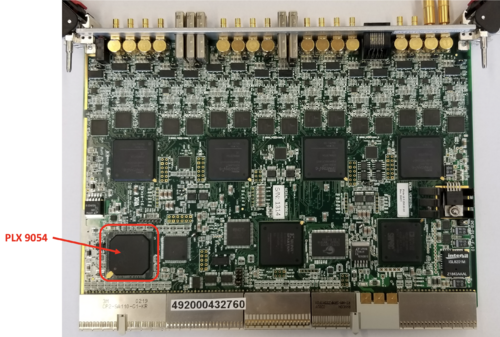Pixie16 digitizer: Difference between revisions
| Line 27: | Line 27: | ||
The '''PCI9054''' (or PLX9054) chip is located at the corner of the Pixie16 digitizer. | The '''PCI9054''' (or PLX9054) chip is located at the corner of the Pixie16 digitizer. | ||
The PCI9054 chip requires a driver. The driver is provided by Broadcom, and the package is called [[Pixie16_digitizer#Broadcom_PlxSDK | '''PlxSDK''']] | The PCI9054 chip requires a driver. The driver is provided by Broadcom, and the package is called [[Pixie16_digitizer#Broadcom_PlxSDK | '''PlxSDK''']]. | ||
After the driver for the PCI9054 chip is done, the DAQ PC can talk to the digitizer. Next, the [[Pixie16_digitizer#Pixie_SDK |'''PixieSDK''']] has to be installed for controlling the digitizer. The PixieSDK provides methods to control the digitizer. | After the driver for the PCI9054 chip is done, the DAQ PC can talk to the digitizer. Next, the [[Pixie16_digitizer#Pixie_SDK |'''PixieSDK''']] has to be installed for controlling the digitizer. The PixieSDK provides methods to control the digitizer. | ||
Revision as of 12:50, 15 April 2022
Introduction
In order to control the Pixie16 digitizer, the DAQ computer needs to recognize the digitizer via a PCIe card( for example NI PCI-8366).
The digitizer crate (XIA PXI CompactPCI) has 14-slot. The 1st slot must be the communication card (for example, NI PXI-8366). The remaining 13 slots can be used for digitizer and other modules.
The PCIe card and PXI Board requires no driver. The DAQ computer will treat it as a bridge.
In the computer (LINUX), using the command lspci to show the PCI connection
>lspci
as an example, part of the output:
04:00.0 PCI bridge: Intel Corporation 41210 [Lanai] Serial to Parallel PCI Bridge (A-Segment Bridge) (rev 09) 04:00.2 PCI bridge: Intel Corporation 41210 [Lanai] Serial to Parallel PCI Bridge (B-Segment Bridge) (rev 09) 05:0f.0 Unassigned class [ff00]: National Instruments PXI-8368 06:05.0 PCI bridge: Texas Instruments PCI2050 PCI-to-PCI Bridge (rev 02) 06:0f.0 Bridge: PLX Technology, Inc. PCI9054 32-bit 33MHz PCI <-> IOBus Bridge (rev 0b)
In the above output, the NI PXI-8368 board on the crate is detected. Also the PCI9054 communication chip is detected.
The PCI9054 (or PLX9054) chip is located at the corner of the Pixie16 digitizer.
The PCI9054 chip requires a driver. The driver is provided by Broadcom, and the package is called PlxSDK.
After the driver for the PCI9054 chip is done, the DAQ PC can talk to the digitizer. Next, the PixieSDK has to be installed for controlling the digitizer. The PixieSDK provides methods to control the digitizer.
Versions of Pixie16 Digitizer
In FSU, we have 100MHz (sampling rate) models and 250 MHz models.
500 MHz models are also used in Clarion2.
Each model has 16 channels. Using connector ?? </red>
Broadcom PlxSDK
The chip was a product of PLX Technology, acquired by Broadcom Inc in 2014. The chipset driver is now called the Broadcom PCI/PCIe Software Development Kits [1]. The package provides complete documentation and driver. The last release is on 2020.
Because of that, it only support Linux kernel around that time. I tested on
| OS | Status |
| Debian 10 | OK |
| Debian 11 | Error |
| Ubuntu 20 | Error |
installation
After downloaded the package, unzip it, and we have
├── Documentation │ ├── PLX API DLL with Visual Basic.htm │ ├── PLX_LegacyAPI.pdf │ ├── PlxRdkReferenceGuide.htm │ ├── PLX_SDK_General_FAQ.pdf │ ├── PLX_SDK_Linux_Release_Notes.htm │ ├── PLX_SDK_Release_Notes.htm │ └── PlxSdkUserManual.pdf └── PlxSdk.tar
The tarball contains the driver. I extract the tarball into /usr/opt/PlxSdk. To setup the package (make) and also make the driver:
~>cd /usr/opt/PlxSdk/ PlxSdk>export PLX_SDK_DIR=$(pwd) PlxSdk>sudo make # This shold make everything, including things in Samples PlxSdk>cd Driver PlxSdk/Driver>export PLX_CHIP=9054 PlxSdk/Driver>sudo ./builddriver 9054 PlxSdk>cd ../Bin PlxSdk/Bin>sudo ./Plx_load 9054 Install: Plx9054 Load module......... Ok (/usr/opt/PlxSdk/Driver/Source.Plx9000/Output) Verify load......... Ok Get major number.... Ok (MajorID = 243) Create node path.... Ok (/dev/plx) Create nodes........ Ok (/dev/plx/Plx9054)
In the last step, it loads the 9054 driver to the Linux Kernel. Fro more detail, see | elog
Load 9054 driver on start up
To make the driver get loaded on start up, create a file at /etc/systemd/system/, say broadcom.service
[Unit] Description=Broadcom PCI/PCIe 9054 Driver After=network.target [Service] Type=oneshot Environment=PLX_SDK_DIR=/usr/opt/PlxSdk/ ExecStart=/bin/bash /usr/opt/PlxSdk/Bin/Plx_load 9054 ExecStop=/bin/bash /usr/opt/PlxSdk/Bin/Plx_unload 9054 RemainAfterExit=yes [Install] WantedBy=multi-user.target
and then
sudo systemctl daemon-reload sudo systemctl enable broadcom.service
Pixie SDK
PixieSDK provides all methods to control the digitizer, from parameters setting, writing/reading control register, starting and stopping the DAQ, to retrieving recorded data from its Extern FIFO (first-in-first-out) memory.
Data Structure
The extern FIFO or ExtFIFO contains word, each word is 32 bit long. A minimum data block contains 4 words.
When retrieving the extern FIFO,
PixieSDK 3.2
The SDK can be downloaded from GitHub in here.
The methods are listed in this web page.
PixieSDK 3.3
PixieSDK 3.3 is similar to 3.2.
Legacy PixieSDK
DAQ Programs
NSCL DAQ
used in Clerion2
The DAQ programs used in Clerion2 are developed by Jame M. Allmond and Tim Gray from ORNL.
PixieDAQ
PixieDAQ is a GUI program for completely controlling and taking data from Pixie16 digitizer, developed by Ryan Tang. The program used the PixieSDK 3.3 and ROOT 6.24.
NSCOPE
nscope is a GUI program for setting digitizer parameters, developed by David Caussyn. The program used the Legacy PixieSDK, CERN ROOT 5.

